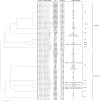Analysis of Multilocus Sequence Typing and Virulence Characterization of Listeria monocytogenes Isolates from Chinese Retail Ready-to-Eat Food
- PMID: 26909076
- PMCID: PMC4754575
- DOI: 10.3389/fmicb.2016.00168
Analysis of Multilocus Sequence Typing and Virulence Characterization of Listeria monocytogenes Isolates from Chinese Retail Ready-to-Eat Food
Abstract
Eighty Listeria monocytogenes isolates were obtained from Chinese retail ready-to-eat (RTE) food and were previously characterized with serotyping and antibiotic susceptibility tests. The aim of this study was to characterize the subtype and virulence potential of these L. monocytogenes isolates by multilocus sequence typing (MLST), virulence-associate genes, epidemic clones (ECs), and sequence analysis of the important virulence factor: internalin A (inlA). The result of MLST revealed that these L. monocytogenes isolates belonged to 14 different sequence types (STs). With the exception of four new STs (ST804, ST805, ST806, and ST807), all other STs observed in this study have been associated with human listeriosis and outbreaks to varying extents. Six virulence-associate genes (inlA, inlB, inlC, inlJ, hly, and llsX) were selected and their presence was investigated using PCR. All strains carried inlA, inlB, inlC, inlJ, and hly, whereas 38.8% (31/80) of strains harbored the listeriolysin S genes (llsX). A multiplex PCR assay was used to evaluate the presence of markers specific to epidemic clones of L. monocytogenes and identified 26.3% (21/80) of ECI in the 4b-4d-4e strains. Further study of inlA sequencing revealed that most strains contained the full-length InlA required for host cell invasion, whereas three mutations lead to premature stop codons (PMSC) within a novel PMSCs at position 326 (GAA → TAA). MLST and inlA sequence analysis results were concordant, and different virulence potentials within isolates were observed. These findings suggest that L. monocytogenes isolates from RTE food in China could be virulent and be capable of causing human illness. Furthermore, the STs and virulence profiles of L. monocytogenes isolates have significant implications for epidemiological and public health studies of this pathogen.
Keywords: Listeria monocytogenes; MLST; PMSC; epidemic clones; inlA; virulence genes.
Figures



Similar articles
-
Prevalence, Genotypic Characteristics and Antibiotic Resistance of Listeria monocytogenes From Retail Foods in Bulk in Zhejiang Province, China.Front Microbiol. 2019 Jul 25;10:1710. doi: 10.3389/fmicb.2019.01710. eCollection 2019. Front Microbiol. 2019. PMID: 31402906 Free PMC article.
-
Listeria monocytogenes Isolates Carrying Virulence-Attenuating Mutations in Internalin A Are Commonly Isolated from Ready-to-Eat Food Processing Plant and Retail Environments.J Food Prot. 2016 Oct;79(10):1733-1740. doi: 10.4315/0362-028X.JFP-16-145. J Food Prot. 2016. PMID: 28221857
-
Heterogeneity, Characteristics, and Public Health Implications of Listeria monocytogenes in Ready-to-Eat Foods and Pasteurized Milk in China.Front Microbiol. 2020 Apr 15;11:642. doi: 10.3389/fmicb.2020.00642. eCollection 2020. Front Microbiol. 2020. PMID: 32351479 Free PMC article.
-
Molecular subtyping and virulence gene analysis of Listeria monocytogenes isolates from food.Food Microbiol. 2013 Aug;35(1):58-64. doi: 10.1016/j.fm.2013.02.014. Epub 2013 Mar 14. Food Microbiol. 2013. PMID: 23628615
-
Current methodologies available to evaluate the virulence potential among Listeria monocytogenes clonal complexes.Front Microbiol. 2024 Oct 10;15:1425437. doi: 10.3389/fmicb.2024.1425437. eCollection 2024. Front Microbiol. 2024. PMID: 39493856 Free PMC article. Review.
Cited by
-
Genomic Characterization of Clinical Listeria monocytogenes Isolates in Beijing, China.Front Microbiol. 2021 Dec 10;12:751003. doi: 10.3389/fmicb.2021.751003. eCollection 2021. Front Microbiol. 2021. PMID: 34956116 Free PMC article.
-
Genetic diversity and virulence profiles of Listeria monocytogenes recovered from bulk tank milk, milk filters, and milking equipment from dairies in the United States (2002 to 2014).PLoS One. 2018 May 9;13(5):e0197053. doi: 10.1371/journal.pone.0197053. eCollection 2018. PLoS One. 2018. PMID: 29742151 Free PMC article.
-
Assessment of the molecular epidemiology and genetic multiplicity of Listeria monocytogenes recovered from ready-to-eat foods following the South African listeriosis outbreak.Sci Rep. 2022 Nov 22;12(1):20129. doi: 10.1038/s41598-022-20175-x. Sci Rep. 2022. PMID: 36418424 Free PMC article.
-
Molecular and Conventional Analysis of Acute Diarrheal Isolates Identifies Epidemiological Trends, Antibiotic Resistance and Virulence Profiles of Common Enteropathogens in Shanghai.Front Microbiol. 2018 Feb 9;9:164. doi: 10.3389/fmicb.2018.00164. eCollection 2018. Front Microbiol. 2018. PMID: 29556217 Free PMC article.
-
Characterization of Listeria monocytogenes Strains Isolated in Palermo (Sicily and Italy) during the Years 2018-2020 from Severe Cases of Listeriosis.Antibiotics (Basel). 2024 Jan 6;13(1):57. doi: 10.3390/antibiotics13010057. Antibiotics (Basel). 2024. PMID: 38247616 Free PMC article.
References
-
- Chen M., Wu Q., Zhang J., Yan Z., Wang J. (2014). Prevalence and characterization of Listeria monocytogenes isolated from retail-level ready-to-eat foods in South China. Food Control 38, 1–7. 10.1016/j.foodcont.2013.09.061 - DOI
LinkOut - more resources
Full Text Sources
Other Literature Sources
Miscellaneous

